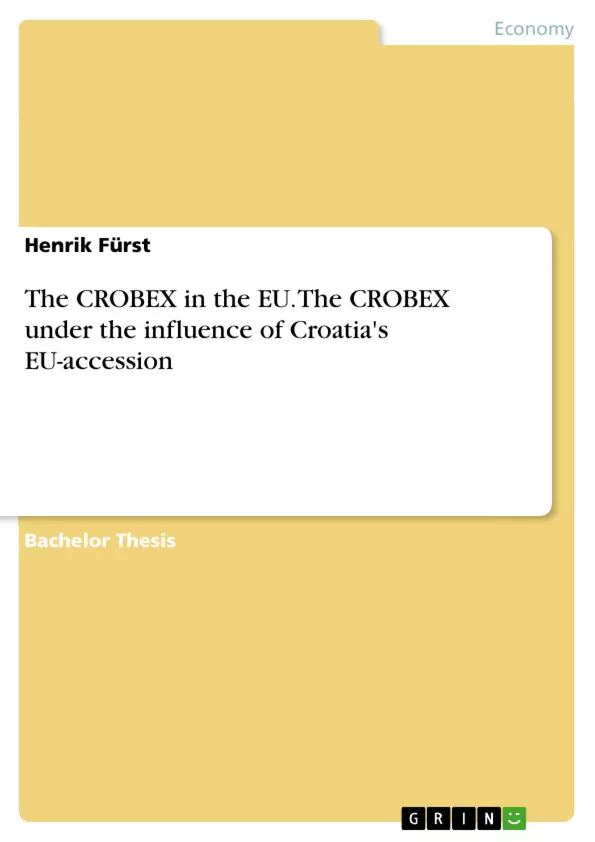The EU integration process is a complex process which introduces many economical and social changes. The new introduced member state is willing to integrate and adapt to the EU's "blueprint". On one side this process brings a lot of benefits; such as abolishment of borders, new job possibilities and in general a chance for a better economy and social wealth. But on the other side it also means that individuality and identity need to play secondary role.
The capital market is a very important fundament in a national economy. The influence of an EU accession on the capital market and its main index, is the essence of this thesis. The CROBEX, Croatia's main index, will be the investigation instrument, the youngest since Croatia is the youngest member in the EU.
The thesis is divided into two main parts. The first part will introduce the fundamentals of the financial market and the complexity of the EU accession progress. Further the complexity of investors reaction and interpretation is made, by presenting different types of events which can influence the stock market. The two main integration categories, which is partly the effect of the EU accession, are presented at the end of this part.
The second part presents the main content of this thesis, Croatia. The process of its EU accession and current economical situation is presented firstly. Followed by an insight of its financial market, the thesis finishes with the analysis of how the EU accession of Croatia did influence its index CROBEX.
Inhaltsverzeichnis (Table of Contents)
- Abstract
- Abbreviation
- List of Figures
- 1. Introduction
- 1.1 Problem Statement
- 1.2 Research Question
- 2. Financial markets and the European Union
- 2.1 The Fundamentals of financial markets
- 2.1.1 Classifying different types of financial markets
- 2.1.2 Basic Definitions for stock market analysis
- 2.1.3 Factors influencing the value of a stock
- 2.1.3.1 Political and macroeconomic events
- 2.2 Economic Integration in the European Union
- 2.2.1 History and integration process
- 2.2.2 Effects of European Integration on the economies and financial markets of member states
- Part II: Empirical Case Study for Croatia
- 3. Overview of Croatia's EU accession and current economic situation
- 3.1 Characteristics
- 3.2 Croatia's EU accession
- 3.2.1 History
- 3.2.2 Accession problems
- 3.2.3 Croatia the 28'th member state
- 3.3 Main economic indicators
- 3.3.1 Unemployment
- 3.3.2 Growth
- 3.3.3 Inflation
- 3.3.4 Indebtedness in foreign countries
- 3.3.5 Trade industry
- 4. Croatia's Financial Market
- 4.1 Financial system and stock market
- 4.2 ZSE - Zagreb Stock Exchange
- 4.2.1 CROBEX
- 4.2.1.1 Development of the CROBEX
- 5. The stock market effect of the EU accession: Analysis of CROBEX
- 5.1 Analytical part I: fluctuations during accession negotiations
- 5.2 Analytical part II: economic effect
- 5.2.1 The economic effect of the EU accession
- 5.2.2 CROBEX chart 2007 - 2014
- 5.3 Main findings
- 6. Conclusion
- 7. References
- 8. Appendix
- The complexity of EU accession and its effects on national economies and financial markets.
- The role of the capital market in a national economy.
- The impact of political and macroeconomic events on stock markets.
- The analysis of Croatia's EU accession and its economic situation.
- The impact of Croatia's EU accession on the CROBEX index.
- Chapter 1: Introduction introduces the research problem and question, which focuses on the influence of Croatia's EU accession on its capital market and the CROBEX index.
- Chapter 2: Financial Markets and the European Union provides a foundation for the research by exploring the fundamentals of financial markets, different types of financial markets, and factors influencing stock values. It also covers the history and process of economic integration in the EU, including its effects on member states' economies and financial markets.
- Chapter 3: Overview of Croatia's EU Accession and Current Economic Situation presents a detailed overview of Croatia's EU accession process, its current economic situation, and key economic indicators such as unemployment, growth, inflation, indebtedness, and trade.
- Chapter 4: Croatia's Financial Market explores the structure of Croatia's financial system and stock market, focusing on the Zagreb Stock Exchange (ZSE) and its main index, the CROBEX.
- Chapter 5: The Stock Market Effect of the EU Accession: Analysis of CROBEX presents an analysis of the CROBEX index, examining its fluctuations during accession negotiations and the economic impact of the EU accession. This chapter analyzes the relationship between the EU accession and Croatia's stock market performance.
Zielsetzung und Themenschwerpunkte (Objectives and Key Themes)
This thesis investigates the impact of the EU accession process on the Croatian capital market and its main index, the CROBEX. It aims to analyze how Croatia's integration into the EU has affected its stock market performance and investor behavior.
Zusammenfassung der Kapitel (Chapter Summaries)
Schlüsselwörter (Keywords)
This research is centered around the EU integration process, its impact on Croatia's capital market, and the CROBEX index. Key terms include EU accession, financial markets, stock market analysis, economic integration, investor behavior, macroeconomic events, and the CROBEX index.
- Citation du texte
- Henrik Fürst (Auteur), 2014, The CROBEX in the EU. The CROBEX under the influence of Croatia's EU-accession, Munich, GRIN Verlag, https://www.grin.com/document/353527



